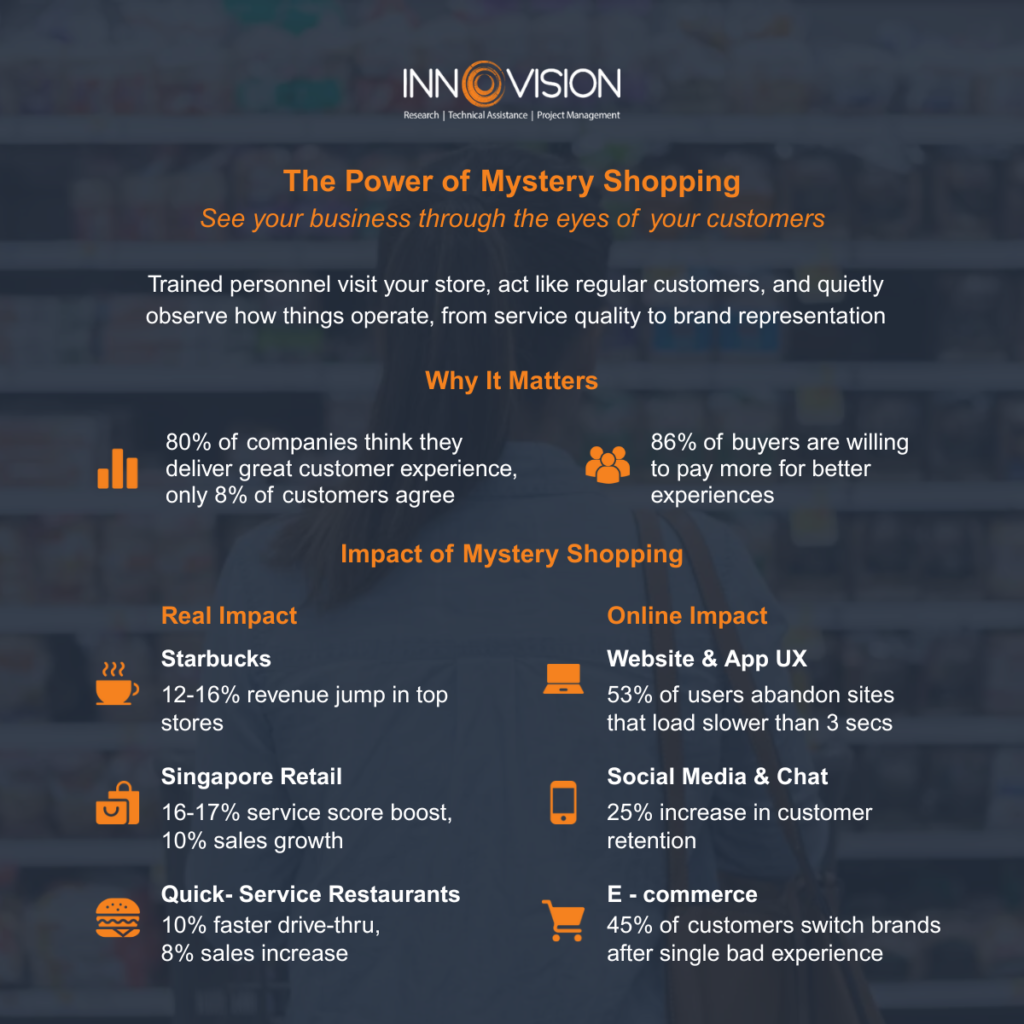
Imagine walking into your store as a customer, seeing, hearing, and feeling everything exactly as they do. Would your employees greet you with genuine warmth? Would the service be seamless, or would you spot missed opportunities to delight? This is the power of mystery shopping: an unfiltered, real-world lens into the customer experience that surveys and data alone can’t replicate.
In an era where 86% of buyers will pay more for a better customer experience (PwC, 2018), businesses can’t afford to guess how they’re perceived. Mystery shopping cuts through assumptions, exposing gaps in service, inconsistencies in branding, and untapped opportunities to turn satisfied customers into loyal advocates. From retail giants like Starbucks to Singapore’s Metro and VivoCity—where mystery shopping drove double-digit sales growth—this tool transforms anonymous transactions into actionable insights.
What is Mystery Shopping
Mystery shopping involves trained evaluators posing as typical customers to assess real-world performance across key touchpoints, such as retail stores, restaurants, banks, or even healthcare facilities. This method allows businesses to evaluate frontline employee performance, ensure brand consistency, and measure operational efficiency in ways that surveys cannot.
Unlike traditional surveys, which rely on customers’ recollection and emotional bias, mystery shopping delivers objective, actionable insights based on predefined criteria. These criteria might include staff courtesy, adherence to brand standards, or speed of service. The feedback generated helps organizations pinpoint service gaps, benchmark their performance against competitors, and develop targeted training programs to reinforce desired behaviors. A landmark study by Bain & Company highlighted a critical disconnect in customer experience: 80% of companies believe they deliver a superior experience, yet only 8% of customers agree (Bain & Company, 2005). This gap has real financial consequences: research shows that a 5% rise in customer retention can increase profits by 25% or more, making mystery shopping’s role in improving experiences directly tied to bottom-line results (Shelvz). Mystery shopping bridges this gap by revealing what’s actually happening at the point of service.

Case Stories
The impact of mystery shopping is tangible and measurable. For example, Starbucks’ “Customer Snapshot” program, which deployed mystery shoppers to evaluate stores three times per quarter, drove a 12–16% revenue increase in locations that improved their service from “good” to “exceptional” (Harvard Business School, 2004). Similarly, a major quick-service restaurant chain leveraged mystery shopping to reduce drive-thru wait times by 10%, resulting in an 8% sales uplift (HS Brands Global).
Beyond immediate performance improvements…73% of companies using mystery shopping report improved customer satisfaction, with many seeing up to 25% increases in customer retention (Shelvz). Research by Hesselink et al. (2004) emphasizes that customer satisfaction alone is insufficient for sustaining service excellence; proactive tools like mystery shopping are essential for driving continuous improvement.
A case study on Singapore’s retail sector by Lynee Low demonstrates the significant impact of mystery shopping on service quality and sales. Both Metro and VivoCity, the retailers examined, showed a clear positive correlation: Metro achieved a 16% improvement in mystery shopping scores and a 10% sales increase, while VivoCity saw a 17% score improvement leading to a 10% sales boost. These gains, which outpaced the general retail market, were linked to comprehensive service interventions like staff training and stakeholder engagement, underscoring the value of actionable feedback and ethical practices in driving business success.
New Frontiers of Mystery Shopping
The scope of mystery shopping has also evolved to meet modern demands. With the rise of digital interactions, mystery shopping now extends to online platforms, mobile apps, and social media engagement. Evaluators assess website usability, response times to customer inquiries, and even the tone of digital communications. In an era where 53% of users abandon websites that take over three seconds to load (Think with Google), digital performance is critical, not just for convenience, but for customer retention. With 80% of customers more likely to remain loyal to brands offering consistently positive experiences, and the global mystery shopping market projected to grow from $2.2 billion (2024) to $3.2 billion by 2032 (Shelvz). This adaptability makes mystery shopping relevant in an increasingly omnichannel world (University of Nevada, 2011) .
Mystery shopping can enhance employee engagement when implemented thoughtfully. Rather than being perceived as “spying,” transparent mystery shopping programs provide employees with constructive feedback, empowering them to improve.
Mystery shopping also offers a competitive edge by providing insights into how a brand stacks up against its rivals. For example, a retail chain might use mystery shoppers to compare their checkout process with competitors’, identifying areas where they can differentiate themselves.
Critics may argue that mystery shopping places undue pressure on employees, but when executed with clear communication and a focus on development, it becomes a catalyst for growth. It’s not about catching employees off guard—it’s about equipping businesses with the insights needed to align operations with customer expectations. As competition intensifies and consumer expectations rise, mystery shopping remains a critical tool for staying ahead.
Sources
- https://www.pwc.com/us/en/advisory-services/publications/consumer-intelligence-series/pwc-consumer-intelligence-series-customer-experience.pdf
- https://www.bain.com/insights/closing-the-delivery-gap/
- https://nadiamarketing.com.br/site/wp-content/uploads/2019/01/casostarbuck24509.pdf?
- https://hsbrands.com/the-roi-of-mystery-shopping-data-and-success-stories/
- https://oasis.library.unlv.edu/cgi/viewcontent.cgi?article=2066&context=thesesdissertations
- https://www.thinkwithgoogle.com/consumer-insights/consumer-trends/mobile-site-load-time-statistics/
- https://www.shelvz.com/superior-customer-experience-through-a-mystery-shopping-solution/
Author: Soumik Siddique Plaban, an Associate in the Data Analytics & Emerging Frontiers Portfolio at Innovision Consulting